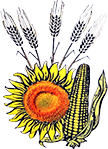Using Molecular Markers to Determine the Genetic Diversity of Wild Sunflower Species
Elena-Laura Conțescu, Florin-Gabriel Anton, Matilda Ciucă, Daniel Cristina, Alina-Gabriela Turcu, Violeta Ionescu
National Agricultural Research and Development Institute Fundulea
Keywords: sunflower, wild species, diversity, ISSR markers.
Abstract: The sunflower (Helianthus annuus L.) is a part of the Asteraceae family, one of the most diverse and extensive family of flowering plants. The Helianthus genus consists in 51 species and 19 subspecies, from which 14 are annual species and 37 are perennial.
Given the high economic importance of sunflower crops, breeders are constantly concerned with identifying new sources to obtain lines/hybrids with improved agronomic traits. Due to the limited genetic basis of cultivated sunflower genotypes, wild sunflower species may represent new sources of genetic variability for the introgression of traits of interest such as: resistance to biotic, abiotic factors, high oil content etc.
One of the most utilized method in determining the degree of diversity within and between the sunflower populations is based on molecular marker use, respectively polymerase chain reaction (PCR) amplifications. They are several techniques like: RAPD (Randomly Amplified Polymorphic DNA), AFLP (Amplified Fragment Length Polymorphism) or SSR (Simple Sequence Repeats) but they can have significant limitations in their use. Instead, ISSR technique has the ability to overcome these limitations and can be used to detect the genetic variations in determining mutant varieties due to the high level of polymorphism provided by the ISSR markers.The aim of this study was to analyze the genetic diversity of the genetic material obtained from cross between wild sunflower species (Helianthus maximiliani, Helianthus argophyllus, Helianthus debilis and Helianthus neglectus) and cultivated genotypes of Helianthus anuus.
Molecular analyzes performed with 19 ISSR markers revealed polymorphism for only ten markers, genetic variability at interspecific but also intraspecific level being noticed.
The results of this study may be useful in future breeding programs.
